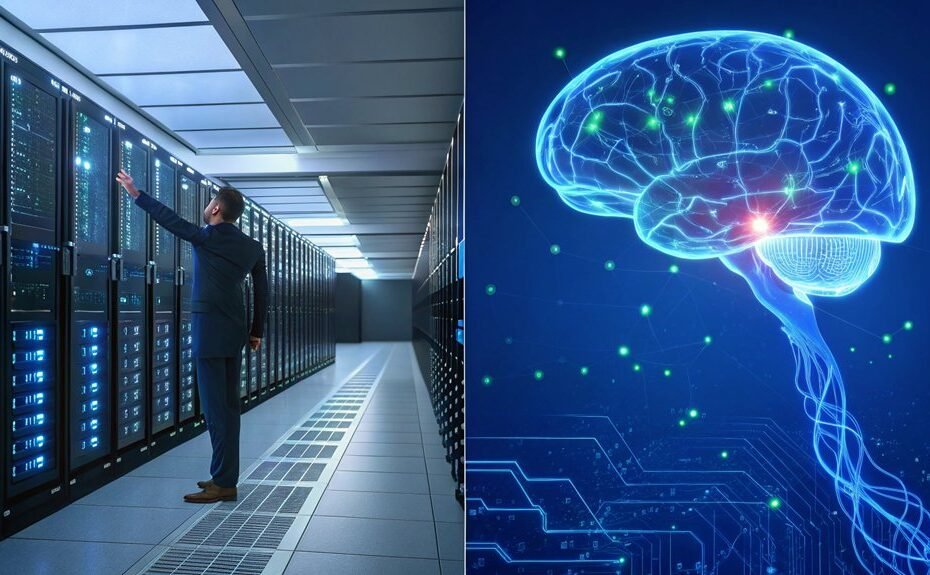Artificial intelligence and machine learning will exhibit seven key distinctions by 2025, according to industry projections. AI systems focus on broader intelligence simulation across domains like robotics and NLP, while ML specializes in data-driven pattern recognition and predictions. AI can function through rule-based approaches without extensive data, whereas ML requires large datasets for learning. Their divergent capabilities shape adoption patterns across industries, with AI offering wider applications and ML excelling in specific data-intensive tasks. Understanding these fundamental differences reveals the transformative potential of both technologies.
While artificial intelligence and machine learning are often used interchangeably, these technologies represent distinct approaches to computational advancement. AI encompasses a broader scope, aiming to simulate human intelligence across various domains including robotics, natural language processing, and computer vision. Machine learning, operating as a subset of AI, focuses specifically on systems that learn and improve from data exposure, primarily in pattern recognition and decision-making applications. Learning mechanisms in AI can be either rule-based or learning-based.
AI and ML differ fundamentally: AI simulates broad human intelligence, while ML specifically learns from data to recognize patterns.
The fundamental distinction lies in their approach to problem-solving. AI systems can function through rule-based decision-making without requiring extensive data, while ML models depend heavily on large datasets to identify patterns and make predictions. This dependency influences their practical applications, with AI powering smart assistants and autonomous vehicles, while ML excels in recommendation systems and speech recognition platforms. Professionals in these fields command high salary ranges, with AI researchers and ML specialists earning between $100,000 to over $300,000 annually.
The technologies differ markedly in their learning processes and adaptability. ML systems inherently learn from data without explicit programming, continuously improving through data processing and pattern recognition. AI, conversely, can integrate multiple learning methods, including but not limited to machine learning, and may operate effectively with or without extensive data training.
Industry adoption patterns reveal another key difference. While both technologies are transforming business operations, AI finds broader application across various sectors because of its thorough approach to intelligence simulation. ML, meanwhile, dominates in data-intensive applications where pattern recognition and predictive capabilities are paramount.
The technologies additionally diverge in their handling of decision-making processes. AI encompasses everything from simple rule-based systems to complex neural networks, while ML relies primarily on statistical models and data-driven algorithms. This distinction becomes particularly relevant in dynamic environments, where ML's adaptive capabilities through continuous data processing prove especially valuable.
Looking toward 2025, these differences are expected to become more pronounced. AI systems are projected to evolve toward less data dependency, while ML continues to focus on achieving higher accuracy with smaller datasets. Privacy considerations further differentiate the technologies, with ML's inherent data requirements necessitating more stringent security measures for sensitive information handling.
The evolution of both technologies points toward increasing sophistication, with AI expanding its cognitive capabilities across multiple domains while ML refines its ability to extract meaningful insights from increasingly complex datasets.
Most-Asked Questions FAQ
Can Machine Learning Algorithms Develop Emotional Intelligence Similar to Humans?
Machine learning algorithms can recognize and respond to emotions through data analysis, but cannot truly develop human-like emotional intelligence because of their inability to genuinely experience feelings.
How Much Data Is Typically Needed to Train a Machine Learning Model?
Data requirements vary considerably by model complexity and task type. Simple models may need hundreds of samples, while complex deep learning systems require millions of data points.
What Programming Languages Are Best for Beginners Learning AI Development?
Python is the ideal starting language for AI development beginners because of its simple syntax, extensive libraries, and abundant learning resources, followed by R for statistical applications.
Can AI Systems Be Completely Unbiased in Decision-Making Processes?
Complete elimination of bias in AI systems is unrealistic because of inherent data biases, human prejudices in development, and societal influences embedded in training datasets and algorithmic design.
What Are the Energy Consumption Differences Between AI and Machine Learning Systems?
AI systems consume substantially more energy than traditional machine learning owing to complex architectures and extensive computational requirements, particularly during training phases and when using GPU-intensive processing.
